The Journey to Found Notre Dame
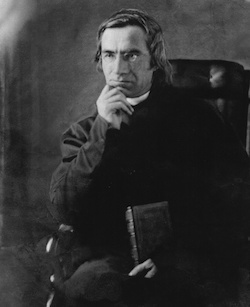 Rev. Edward Frederick Sorin, C.S.C., founded the University of Notre Dame in 1842.
Rev. Edward Frederick Sorin, C.S.C., founded the University of Notre Dame in 1842.
Father Sorin and the Holy Cross Brothers’ mission in the United States took place during the western expansion of the country. The founding of the University of Notre Dame began during periods of great economic, political, and social strife in these territories that were newly annexed to the United States.
Embodying the Congregation of the Holy Cross mission to educate the mind, body, and spirit, Rev. Edward Sorin, C.S.C., set forth from his native France for the Diocese of Vincennes, Indiana, with a missionary zeal to establish schools and educate young Americans in religion, business, and the needs of daily life.
Prologue
In 1833, the Bishops Council of Baltimore met and created new dioceses, one being the Diocese of Vincennes. It included all of the state of Indiana and part of eastern Illinois. Bishop Bruté, a Frenchman was appointed the first Bishop and he served from 1834 to his death in 1839. During his life, he received a tract of land in northern Indiana from Father Badin. Father de la Hailandiere was the coadjutor Bishop to Bruté and succeeded him from 1839 to 1847. He was on a recruiting trip in France at the time of Bruté's death looking for a community of teaching brothers to educate the youth in the Vincennes diocese. He was recommended to meet with a Father Basil Moreau, the founder of the Congregation of Holy Cross which was a group of auxiliary priests and teaching brothers.
Bishop de la Hailandiere asked Father Moreau for three or four Brother teachers. Father Moreau exceeded the Bishop’s request and sent the three Brother teachers (Vincent, Gatian, and Anselm) and also a tailor/cook, a carpenter, and a farmer (Brothers Joachim, Francis Xavier, and Lawrence) and a chaplain (Father Sorin) who had been ordained for two years. Father Sorin proved to be next in importance to Father Moreau in developing and shaping the Congregation of Holy Cross. The group of six Brothers and Father Sorin sailed for America in August 1841.
Father Sorin and the Holy Cross Brothers' journey endures throughout the past 175 years.
Timeline
1717 to 1730
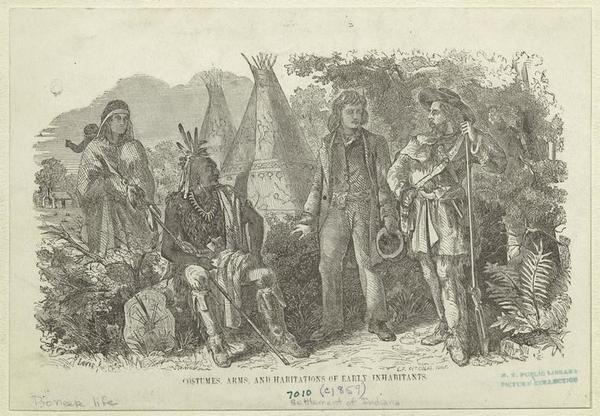 Costumes, Arms, And Habitations Of Early Inhabitants. Lovie, Henri (Artist) Peticolas, Edward F. (b. 1793) (Engraver)
Costumes, Arms, And Habitations Of Early Inhabitants. Lovie, Henri (Artist) Peticolas, Edward F. (b. 1793) (Engraver)
Among the Native Americans who were already established with systems of government, irrigated gardens, raised plant beds, and other organizational structures in present day Indiana, the first Europeans fortified settlements in Indiana created by the French; Ouiatenon (near present day Lafayette), Miamis (present day Fort Wayne), and Vincennes. Long before these settlements were built, French explorers and fur traders, such as La Salle, and missionaries were following the Wabash River in search of prosperity.
1754–1763
The French and Indian War, also known as the Seven Years’ War ended the rule of France in Indiana. On October 10, 1765, the French military at Vincennes officially surrendered to the English. The war was costly for the British and eventually led to the government imposing new taxes on its colonies. As these actions were resisted by the colonies, it eventually led to the American Revolution.
February 25, 1779
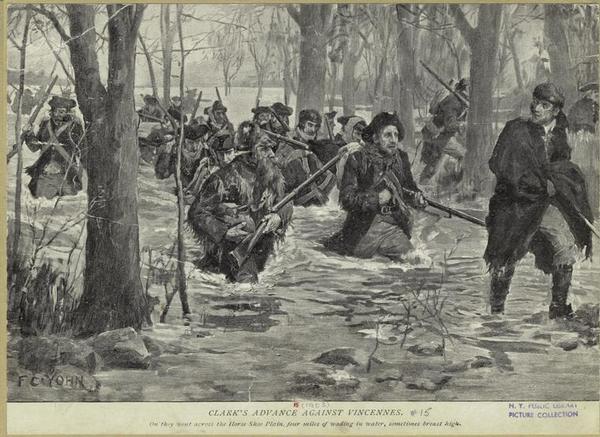 Clark's advance against Vincennes. Yohn, F. C. (Frederick Coffay) (1875-1933) (Artist)
Clark's advance against Vincennes. Yohn, F. C. (Frederick Coffay) (1875-1933) (Artist)
George Rogers Clark, an American military commander, captures Fort Sackville in Vincennes from the British. This was a Revolutionary War battle fought in Indiana on land and water that resulted in the American government gaining control over the fort and the region. The site of this battle in Indiana is a United States National Park.
March 1, 1784
Virginia, formerly under British control, cedes claim to Northwest Territory, including present day Indiana, to the United States.
February 11, 1799
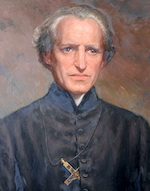 Blessed Basil Moreau, founder of the Congregation of Holy Cross
Blessed Basil Moreau, founder of the Congregation of Holy Cross
Blessed Basil Moreau, the founder of the Congregation of Holy Cross, is born Basile-Antoine Marie Moreau (Basil Anthony Marie Moreau in English) in Laigné-en-Belin, in the diocese of Le Mans, France. He would be forever affected later in life by the spiritual upheaval caused by the French Revolution which ended at the time of his birth. During this time, Church property was seized, priests were executed and arrested and religious communities were expelled from France. Later in life, Basil Moreau’s hope was to fill this vast spiritual and educational gap.
November 7, 1811
The Battle of Tippecanoe, near present-day Lafayette, Indiana between American military led by Governor William Henry Harrison of the Indiana Territory and Native American warriors led by the Shawnee leader Tecumseh. Tecumseh and his brother Tenskwatawa (known as "The Prophet") were leaders of a confederacy of Native Americans from various tribal nations that opposed US expansion into their homelands.
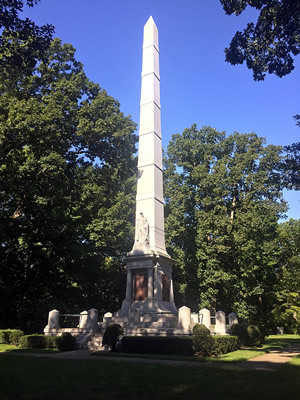 Tippecanoe Battlefield Monument built in 1908
Tippecanoe Battlefield Monument built in 1908
Harrison marched with an army of about 1,000 men to disperse the confederacy's home at Prophetstown, near the confluence of the Tippecanoe and Wabash Rivers. Used as evidence by the Americans that the British were arming the Native peoples, this battle led to a deterioration of relations with Britain and led to the War of 1812, which began six months later.
"After the War of 1812, settlement in Indiana began increasingly to show the effect of the mounting Immigration from Europe. Many of these new Americans were Irish and German Catholics. By 1834, the Diocese of Bardstown in Kentucky had become overtaxed, and a separate diocese for Indiana was created.
The first Bishop was the Most Reverend Simon G. Bruté; de Rémur, a native of France, and the episcopal see was in the old French settlement of Vincennes." (1)
February 6, 1814
In the French province of Mayenne, at the little village of La Roche in the commune of Ahuillé, there lived a gentleman farmer, Julian Sorin de la Gaulterie and his wife, Marie Anne Louise Gresland de la Margalerie. Edward Frederick Sorin was born the seventh of their nine children.
December 11, 1816
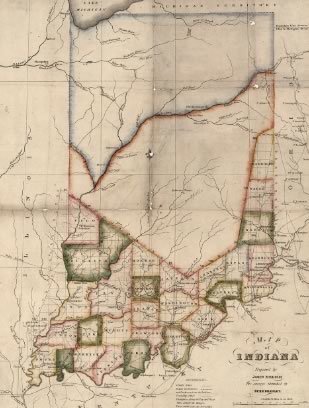 First Map of Indiana
First Map of Indiana
Indiana becomes the 19th state.
July 15, 1820
Father James Dujarie founds the Brothers of St. Joseph (a group of teaching Brothers) in Ruille-sur-Loire, France
July 1830
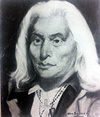 Chief Leopold Pokagon
Chief Leopold Pokagon
Leopold Pokagon, a leader of the Potawatomi in present day Indiana and Michigan, travels to Detroit to ask for priests to return to his native lands. This was a move towards greater identity with Catholicism and the Church. Pokagon and his wife and many of his band were baptized and practicing Catholics.
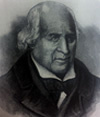 Father Badin
Father Badin
Following this meeting in Detroit, Father Badin soon arrives in Indiana to establish a mission to serve this community. Badin was the first priest ordained in the United States and served as a missionary for sixty years in the Ohio and Mississippi valleys. Sorin affectionately referred to Badin as the “proto-priest.” Father Badin built the first log chapel on the land that would later become the University of Notre Dame.
July 31, 1835
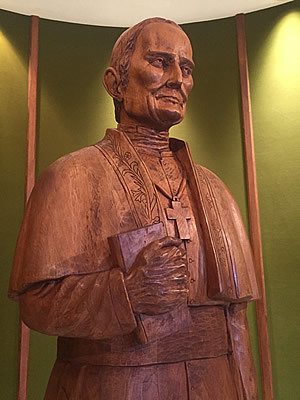 Bishop Bruté; life-sized statue, carved laminated walnut, on display at The Old Cathedral Library and Museum in Vincennes.
Bishop Bruté; life-sized statue, carved laminated walnut, on display at The Old Cathedral Library and Museum in Vincennes.
Father Badin transfers the land in northern Indiana to Bishop Bruté, the first Bishop of the Diocese of Vincennes, the first episcopal see in Indiana.
Bruté, originally from France, made many trips back to France to inspire new priests and brothers to travel to the new world. Father Sorin was inspired by Bruté during one of his recruiting trips. At the time of Bruté's death, the land transferred to his vicar and replacement, Bishop Hailandiere.
March 1, 1837
Father Basil Moreau had gathered a group of Auxiliary Priests in Le Mans, France who conducted parish retreats in 1833-1835. Father James Dujarie's group of Brothers of St. Joseph were teaching in schools around the Le Mans region. Father Moreau had often preached the annual retreats for the Brothers. Father Dujarie was in failing health so he asked Father Moreau to take over the administration of the Brothers of St. Joseph. On that day, the Fundamental Act of Union was signed by both groups (the ten Auxiliary Priests and the fifty Brothers of St. Joseph) to form the Congregation of Holy Cross (Sainte-Croix), the name of the suburb of Le Mans where the merger took place.
August 15, 1840
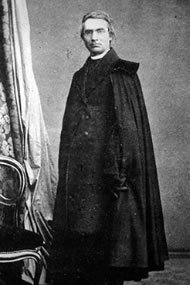 Father Sorin
Father Sorin
Father Sorin officially joins Rev. Basil Moreau’s order and takes vows in the name of the Congregation of Holy Cross.
August 5, 1841
The Bishop of the Diocese of Vincennes, Hailandiere and Blessed Moreau finalize arrangements for the C.S.C. to send missionaries to Indiana. On the Feast of Our Lady of the Snows, Father Sorin and the six Holy Cross Brothers depart France for America. The band of seven left the Mother House at LeMans and on the 8th of August and they set sail from Havre, on the packet ship Iowa, “a large vessel and a good sailer,” as Father Sorin described.
During this first leg of the journey at sea, they were accompanied by a young nun, Sister St. Francis Xavier, who was a member of the Sisters of Providence. She was enroute to Saint Mary-of-the-Woods established in Terre Haute, Indiana in 1840 by Saint Mother Theodore Guerin. The group arrive in America at the New York Harbor a few weeks later.
September 13, 1841
Sorin and the Brothers arrived in New York. “One of his first acts on this soil so much desired was to fall prostrate and embrace it, as a sign of adoption, and at the same time of profound gratitude to God for the blessings of the prosperous voyage. The arrival of the new missionaries could not have taken place at a more striking and propitious time. It was the eve of the Feast of the Exaltation of the Holy Cross, so that Father Sorin was able to celebrate his first mass in America on the day of the feast.” (Excerpted from the History of Notre Dame, Golden Jubilee)
September 16, 1841
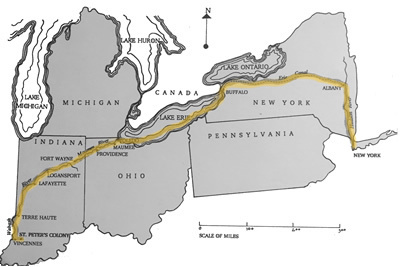
After a rest of three days, they proceeded on their journey to the distant Vincennes, Indiana. Their journey was via a paddle boat from New York City on the Hudson River north to Albany and then west on the Erie Canal. Father Sorin and Brother Vincent visited Niagara Falls on their way to Buffalo and Lake Erie.
The trip on Lake Erie was sometimes very difficult in high winds. They reached Toledo, Ohio and traveled south on the Maumee River. Unfortunately, the Miami Canal was not yet completed so they traveled by land to Fort Wayne, Indiana. When they reached the Wabash River they traveled west to Logansport and Lafayette and then south to Terre Haute en route to Vincennes. During the leg from Logansport to Terre Haute, and at the request of a local priest, a young orphan girl on her way to Saint Mary-of-the-Woods joined the group.
October 10, 1841
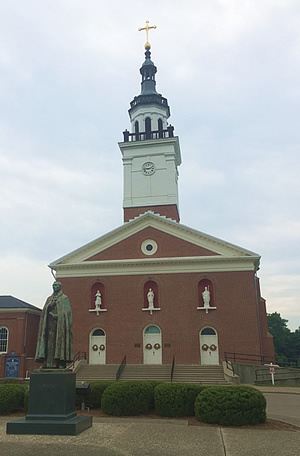 Basilica of St. Francis Xavier, Vincennes, IN. View Interior
Basilica of St. Francis Xavier, Vincennes, IN. View Interior
Father Sorin and the Holy Cross Brothers beheld the tower of the new Cathedral as they arrived in Vincennes about sunrise on the second Sunday of October. They were so filled with joy that they seemed to forget all their previous fatigue and pains of the journey. They blessed God who had granted them the reward of seeing with their own eyes the city of which they had so often spoken during the last months.
October 11, 1841
Father Sorin visits St. Peter Church, a missionary station in Daviess county about twenty-seven miles east of Vincennes. It was one of the oldest missions of the diocese. St. Peter Church had a little frame church in good repair; two little rooms had been added to it, one for the sacristy and one for the priest. Other small buildings were for a kitchen and for a school. It was evident that this was the place best fitted for the purposes of the priest and the Brothers and that here they could at least pass the winter. So the location was selected, and the six Brothers came on from Vincennes. There were one hundred and sixty acres of good land at St. Peter Church, and the little community set to improve it and to establish themselves firmly as a religious house.
October 13, 1841 to November 15, 1842
The newcomers of Holy Cross (one priest and six Brothers) won the goodwill of their neighbors and began to prosper even more than they had anticipated. By the end of the 1841, they became attached to St. Peter Church and began to make preparations to build a college. They also attracted many vocations of young men to join their ranks as Brothers. Thus in late 1842 they had 13 Novice Brothers but within three years nine left the Community, but four became Professed or Vowed Brothers and worked at Notre Dame. In 1843, eight more young men joined as novices, five left but three became vowed Brothers and served at Notre Dame for 15 to 40 years.
Father Sorin's plan was to build the college at St. Peter Church but he met with opposition from the Bishop who already had a Catholic college in Vincennes. The Bishop's plan was for the Brothers to only establish primary schools within the mission stations of the diocese. Father Sorin went to meet with the Bishop many times to change his mind but met with opposition. The result was a continuous running quarrel. Sorin realized that the diocese's population was not large enough to attract college students. Finally the Bishop realized a solution and offered the men of Holy Cross the tract of land he owned (from Bishop Bruté and Father Badin) in northwest Indiana close to South Bend and the St. Joseph River.
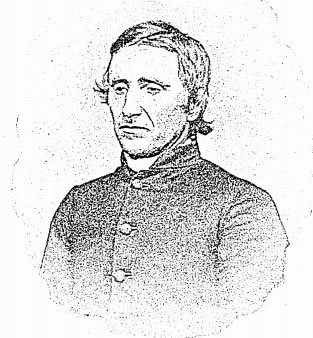 Brother Francis Xavier Patoy, arrived in the United States at age 22 and changed his name from "Marie." He was a carpenter and undertaker. He traveled with Father Sorin from the original colony and to Notre Dame.
Brother Francis Xavier Patoy, arrived in the United States at age 22 and changed his name from "Marie." He was a carpenter and undertaker. He traveled with Father Sorin from the original colony and to Notre Dame.
Father Sorin and the Brothers met to discuss the option and because of the name "St. Joseph" it was seen as providential that they accept the Bishop's land on his condition that they build a College and open a novitiate within two years of arrival. The Holy Cross community were sad to leave St. Peter Church but looked forward to the task ahead in developing the unknown land near South Bend as the dream they wanted, a college to educate the youth in the area.
November 15, 1842
Just before their departure, Father Sorin received a letter from Bishop Hailandiere of Vincennes.
''Dear Confrere: Enclosed find the $310 you asked of me; also a letter of credit on Mr. Coquillard for the sum of $23I. I believe it is what he still owes me. Do not forget that the tax for this year on the land du Lac (Notre Dame du Lac) has not been paid. I offer you my wishes for your success. May the Angels of God accompany you on your way and may Notre Dame du Lac smile at your arrival and bless you! -Oh! my the work you are going to begin make saints! May the merit of the Fathers who, now nearly two ages ago planted the cross which you will find there 'may those of Badin, De Seille, Petit (our dear Benjamin) serve as a cornerstone for the edifice that your piety and zeal prompt you to build... . My hopes are as great as my desires."
November 16 - 26, 1842
In the worst winter on record, Father Sorin and the Brothers journeyed from Vincennes to South Bend. They followed the Wabash River north to Terre Haute, and continued along tracks beside the river through to Lafayette, Logansport, and then directly north to South Bend. Most of the time the men walked, and they guided an oxcart and horses over frozen and difficult terrain.
Excerpt from Notre Dame -- One Hundred Years / by Arthur J. Hope, C.S.C.: "Of the seven Brothers who accompanied Father Sorin, only two were of the original colony from France, Brothers Marie (formerly known as Brother Francis Xavier), and Gatian. The others were Brothers Patrick, William, Basil, Peter, and Francis. These latter had joined the community since its arrival at St. Peter Church. They were all young and robust. Four of them had come from Ireland: Brothers Peter and Patrick, both farmers; Brother Basil, a cooper; and Brother William, a carpenter. They had more than two hundred and fifty miles ahead of them. The weather was bitterly cold every step of the way. They took turns at riding and walking. After a few days of travel, however, Father Sorin decided that he and four of the Brothers should go on ahead, while the other three should follow at a slower pace with the oxen and the laden cart. They finally reached South Bend on November 26th."
November 26, 1842
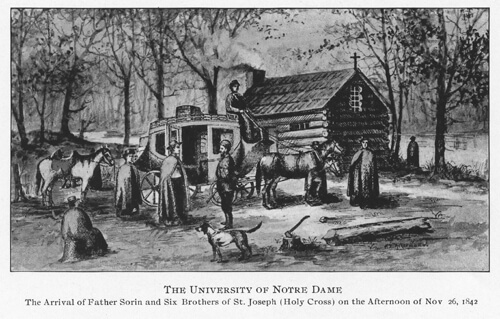
After a long journey in the snow, Father Edward Sorin and several Brothers of Holy Cross arrived at their destination.
In the wilderness of Northern Indiana, at a place known as St. Mary of the Lake, they founded the University of Notre Dame.
December 5, 1842
Father Sorin proclaims the University “… one of the most powerful means of doing good in this country” in his legendary letter to Father Basil Moreau.
February 13, 1843
The remaining Holy Cross family at St. Peter Church leave Vincennes for Notre Dame: Brothers Vincent, Lawrence, and Joachim, six novice Brothers and two postulants. Brother Anselm remained alone in Vincennes to teach in the Cathedral School. They reach Notre Dame on February 27.
March 19, 1843
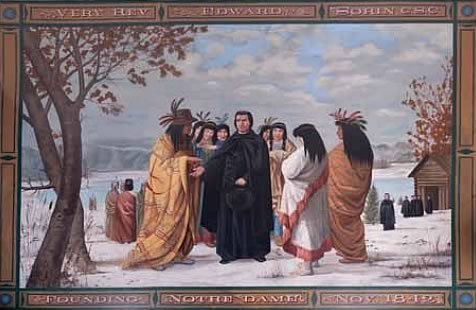 Luigi Gregori, Father Edward Sorin receiving rings in gratitude for saying Mass and baptizing Potawatomi in their community, 1880s, pigment with casein on plaster, Saint Edwards Hall, University of Notre Dame, Notre Dame, Indiana
Luigi Gregori, Father Edward Sorin receiving rings in gratitude for saying Mass and baptizing Potawatomi in their community, 1880s, pigment with casein on plaster, Saint Edwards Hall, University of Notre Dame, Notre Dame, Indiana
The founders finish construction of their first building on campus, the log chapel. Sorin and his brothers continue to grow their relationships with the European settlers and Native Americans in the region, especially the Potawatomi — sharing a long standing history together from the time of Fathers De Seille, Petit, and Badin many years prior in the region.
January 15, 1844
The University of Notre Dame is officially chartered by the Indiana legislature.
August 13–26, 2017
The Notre Dame Trail, in August 2017, will follow a path along the Wabash Valley that includes locations of major historic significance to Native peoples, the states of Indiana and Michigan, the United States, and of course the Church.
Honoring Father Sorin’s inspirational journey and intrepid spirit—our Notre Dame spirit—we will retrace his path from Vincennes to Notre Dame. Today, 175 years later, the mission endures, the journey continues and the work goes on. The Notre Dame Trail is a collective renewal of our determination and a rededication to Notre Dame’s mission. Together, we will continue to follow in the footsteps of great ancestors as we build on successes and forge new trails of knowledge.
Interactive
Interior: Basilica of St. Francis Xavier, Vincennes, IN.
Interior: Log Cabin Chapel, Saint Mary-of-the-Woods, IN
Bibliography
Chronicles of Notre Dame du Lac, Edward Sorin, Editor James T. Connelly, University of Notre Dame Press, 1992
[View on ND Archives]
Notre Dame, One Hundred Years, Arthur J. Hope, University press, 1943
[View on ND Archives]
Edward Sorin, Marvin Richard O'Connell, University of Notre Dame Press, 2001
The University of Notre Dame: A Portrait of Its History and Campus, Thomas J. Schlereth, University of Notre Dame Press, 1976
A Brief History of the University of Notre Dame Du Lac, Indiana From 1842 to 1892: Prepared for the Golden Jubilee, to Be Celebrated June 11, 12 and 13, 1895 (Classic Reprint), University Of Notre Dame, Forgotten Books, 2015
[View on ND Archives]
Notre Dame: Foundations, 1842-1857, John Theodore Wack
[View on ND Archives]